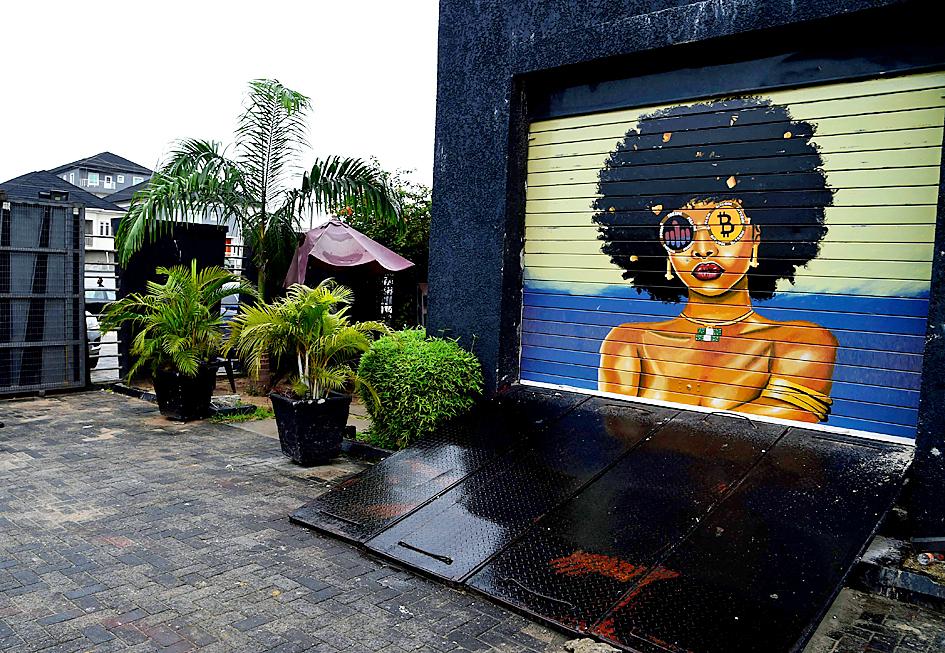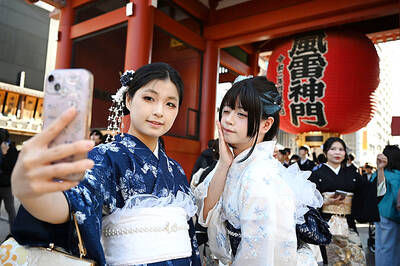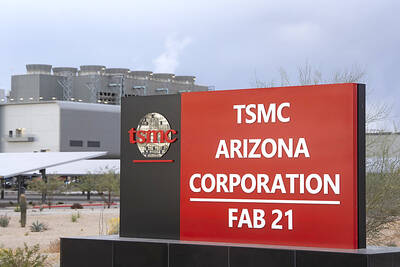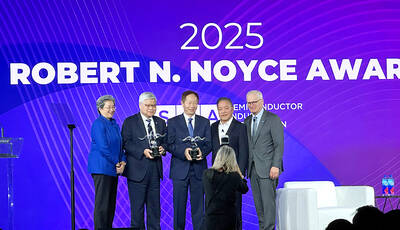At only 29, Nigerian pop-artist Osinachi has sold paintings on Microsoft Word for several thousand euros, or the equivalent amount in ether, a cryptocurrency often used to buy digital art.
One of his works, Becoming Sochukwuma, shows a black dancer wrapped in a tutu made of African fabric, dreadlocks tied in a bun, swirling on a computer screen. However, what makes the painting truly unique is its endorsement with an NFT (non-fungible token) — a set of data stored in a blockchain that is used as a certificate of ownership.
The digital painting was sold in April for US$80,000 worth of virtual money on the crypto-art market, a growing business in Africa’s most populous country.

Photo: Pius Utomi Ekpei / AFP
Worldwide, NFTs, which serve as a unique identifier, have reassured collectors when buying online art and propelled digital artists to stardom.
Between January and May, NFTs generated around US$2.5 billion worth of transactions according to the Web site NonFungible.com, sparking the interest of global auction houses Christie’s and Sotheby’s.
Osinachi’s pieces have done very well on this emerging market and in just a few months the young man has become the most famous African crypto-artist.
He was already using Microsoft Word to paint when he was at university, but “gallerists didn’t care about digital art” until recently, he told Agence France-Presse.
It was in 2017 that he discovered he could sell his artwork directly to buyers using a blockchain — where a record of NFT ownership can be stored.
In the past six months, as cryptocurrencies and NFTs have boomed, digital art like Osinachi’s has thrived.
“Now, galleries are after him,” said Oyindamola Fakeye, creative director at the Center for Contemporary Art in the country’s cultural capital Lagos. “He has a very positive influence on other African digital artists.”
Blockchain, cryptocurrency and NFTs are terms that are no longer foreign to Osinachi, who spends a lot of time in person and online explaining what they are to other artists. Many creative minds and entrepreneurs in Nigeria are inspired by his success.
It’s a “revolution in the art space,” said fellow crypto-artist Niyi Okeowo, whose afro-futurist work combines photography, 3D and graphic design. Nigeria has about “a hundred” digital artists, Okeowo says, and “most have been inspired by Osinachi.”
With its large, youthful, creative and connected population, the West African nation has “the potential to lead” when it comes to NFTs, Osinachi believes.
“We have plenty of talents here. The creative energy in Lagos alone is baffling among young people,” Osinachi said.
Nigerians are also fond of cryptocurrencies, contributing to the success of NFTs.
In times of economic crisis, with a devalued naira, a growing number in the country are chosing to invest in digital currency. Last year, more than US$400 million were exchanged in cryptos, making Nigeria the third-largest user of digital money worldwide, behind the US and Russia, according to Statista, a German company specializing in market and consumer data.
Entrepeneur Uyi Omokaro was an early believer in the potential of NFT in Nigeria. This month, he launched Wearmasters, a platform to sell Africa-made NFT art, where he hopes to bring on some of Nigeria’s most talented emerging artists like 23-year-old painter Daniel Pengrapher.
“Our ambition is to give them international visibility through NFT,” Pengrapher said.
For now, NFT collectors are few in the country. One of them is Michael Ugwu, director of a digital studio in Lagos.
“I’m one of the only ones,” Ugwu said.
He started investing in cryptocurrencies in 2017, after several devaluations of the naira, before discovering his real passion: the crypto-art market.
“The traditional art space can be a little bit snobbish,” Ugwu said.
On the crypto-art market, he says he “found a community, so welcoming, so interactive.”
He owns about “a hundred” NFTs he says proudly, but he also considers them investments.
Ugwu has used NFTs as insurance to obtain loans on the crypto-finance market, a process that would take months in the traditional banking system.
Ugwu remains confident, despite recent crypto crashes that automatically devalue his collections. “Most of my friends think that I’m crazy... Let’s wait and see in 10 years.”

Shiina Ito has had fewer Chinese customers at her Tokyo jewelry shop since Beijing issued a travel warning in the wake of a diplomatic spat, but she said she was not concerned. A souring of Tokyo-Beijing relations this month, following remarks by Japanese Prime Minister Sanae Takaichi about Taiwan, has fueled concerns about the impact on the ritzy boutiques, noodle joints and hotels where holidaymakers spend their cash. However, businesses in Tokyo largely shrugged off any anxiety. “Since there are fewer Chinese customers, it’s become a bit easier for Japanese shoppers to visit, so our sales haven’t really dropped,” Ito

The number of Taiwanese working in the US rose to a record high of 137,000 last year, driven largely by Taiwan Semiconductor Manufacturing Co’s (TSMC, 台積電) rapid overseas expansion, according to government data released yesterday. A total of 666,000 Taiwanese nationals were employed abroad last year, an increase of 45,000 from 2023 and the highest level since the COVID-19 pandemic, data from the Directorate-General of Budget, Accounting and Statistics (DGBAS) showed. Overseas employment had steadily increased between 2009 and 2019, peaking at 739,000, before plunging to 319,000 in 2021 amid US-China trade tensions, global supply chain shifts, reshoring by Taiwanese companies and

Taiwan Semiconductor Manufacturing Co (TSMC, 台積電) received about NT$147 billion (US$4.71 billion) in subsidies from the US, Japanese, German and Chinese governments over the past two years for its global expansion. Financial data compiled by the world’s largest contract chipmaker showed the company secured NT$4.77 billion in subsidies from the governments in the third quarter, bringing the total for the first three quarters of the year to about NT$71.9 billion. Along with the NT$75.16 billion in financial aid TSMC received last year, the chipmaker obtained NT$147 billion in subsidies in almost two years, the data showed. The subsidies received by its subsidiaries —

Taiwan Semiconductor Manufacturing Co (TSMC) Chairman C.C. Wei (魏哲家) and the company’s former chairman, Mark Liu (劉德音), both received the Robert N. Noyce Award -- the semiconductor industry’s highest honor -- in San Jose, California, on Thursday (local time). Speaking at the award event, Liu, who retired last year, expressed gratitude to his wife, his dissertation advisor at the University of California, Berkeley, his supervisors at AT&T Bell Laboratories -- where he worked on optical fiber communication systems before joining TSMC, TSMC partners, and industry colleagues. Liu said that working alongside TSMC